Choosing your B2B marketing team structure hinges on two essential criteria: something that works for your needs now and something that will work in the future.
At the most basic level, you're always looking for something road-worthy — something that can take you (and your passengers) from point A to point B without a hitch (flux capacitor optional, unless you’re going back in time, of course.).

When it comes to different types of B2B organizational structures, it’s important to consider which one serves your goals and allows you to reach your market.
Decisions to make include things like chain of command (long or short?), span of control (wide or narrow?), and centralization (centralized or decentralized decision-making?), among others.
Now, let’s break it down.
Table of Contents
Organizational Structure
A company’s organizational structure is the hierarchy of the business’s teams, leaders, managers, and individual contributors. Organizational structures determine what employees do, who they report to, and how decisions are made.
At a minimum, an org structure chart should include employees’ titles and basic relationships across teams.
To put it simply, an organizational structure is like a map that simply explains how your company works and how its roles are organized. Like me, you’ve probably worked in a variety of organizational structures.
You may know that different types of organizational structures can use functions, markets, products, geographies, or processes as their guide. They can also cater to businesses of specific sizes and industries.
What's the point of an organizational structure? And, as a business leader, do you even need one?
Beyond aiding onboarding, if you need to pivot or shift your leadership, you can visualize how the workflows might change by adjusting your organizational structure diagrams.
.png)
Organizational Structure Guide + Templates
Build a visual org structure with these free templates.
- Functional Org Structure
- Geographical Org Structure
- Process-Based Org Structure
- Market-Based Org Structure
Download Free
All fields are required.
.png)
Four Basic Elements of Organizational Structure
An organizational structure typically has four essential elements — and you can add more building blocks or components depending on your business needs.
I can’t stress this enough: make sure you include the following basic elements.
Chain of Command
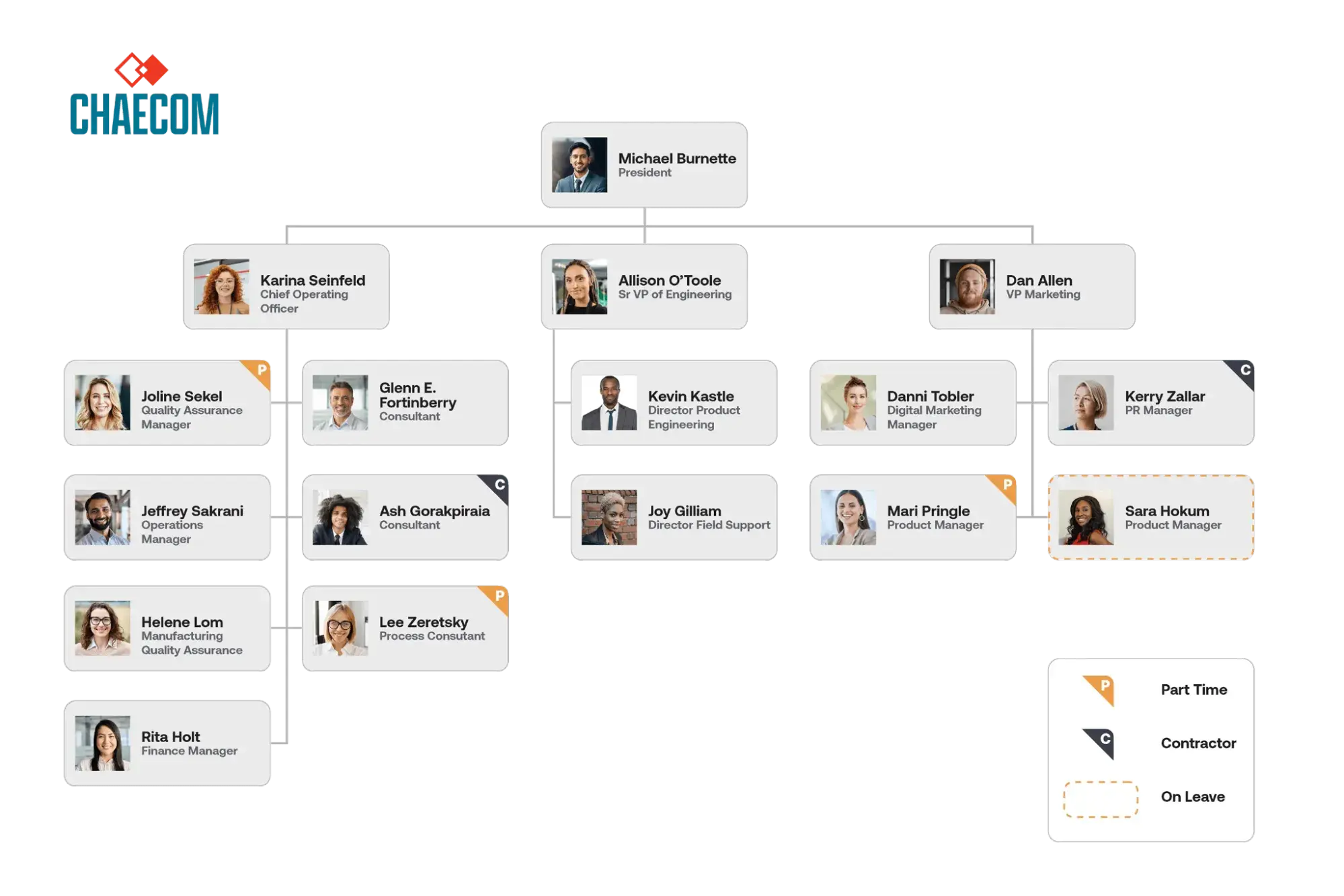
Your chain of command is how tasks are delegated and work is approved. An org structure allows you to define how many "rungs of the ladder" a particular department or business line should have.
In other words, who tells whom to do what? And how are issues, requests, and proposals communicated up and down that ladder?
Best for: Traditional businesses or hierarchical organizations that require clear authority lines and defined roles for decision-making and accountability.
Departmentation

Departmentation is one of the most important elements of your organizational structure. It clusters your teams by similar roles and responsibilities and allows you to understand how each department connects to one another.
Best for: Companies that need specialization by function, product, process, or geography to streamline tasks and improve efficiency.
Span of Control
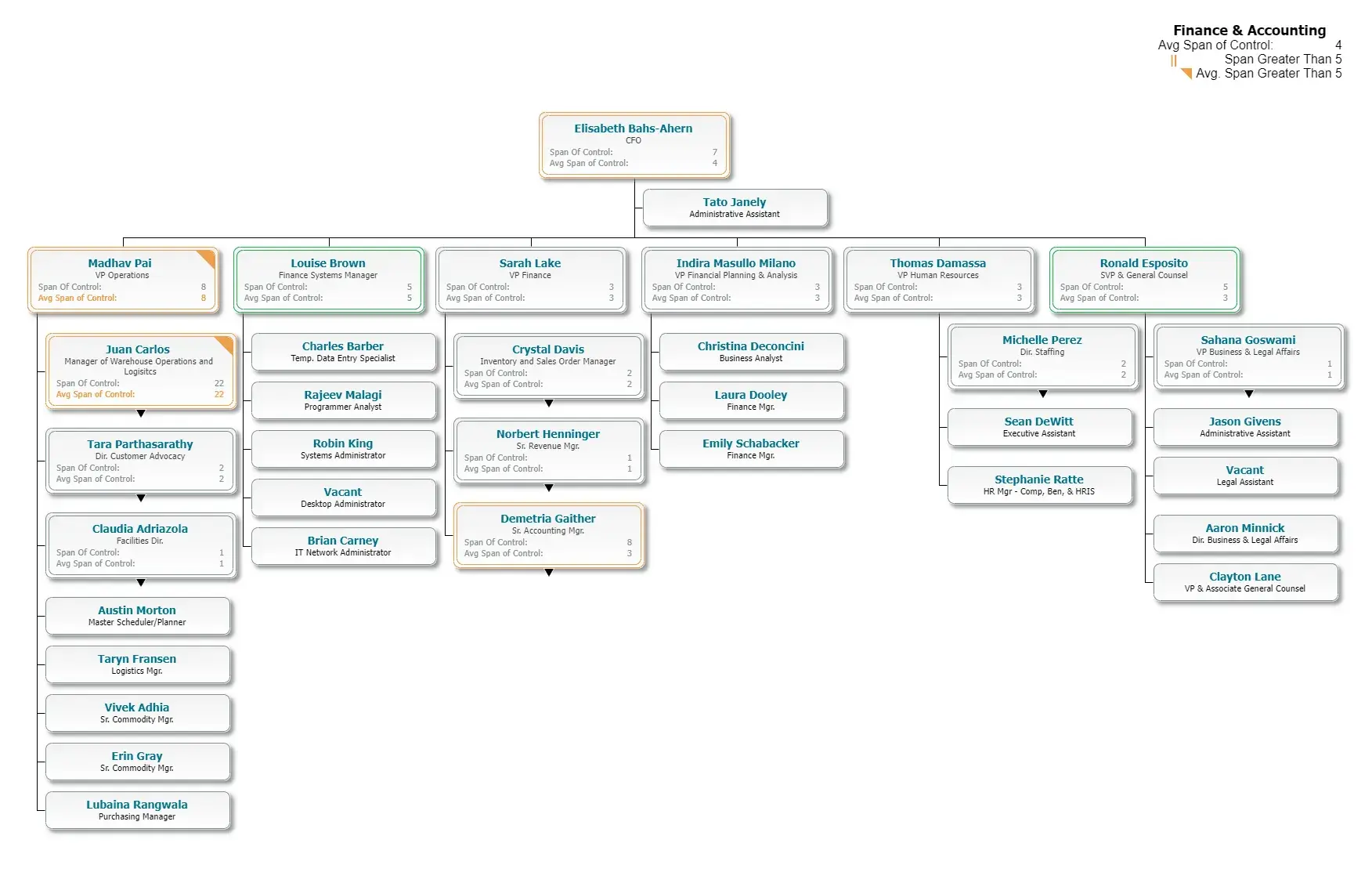
Your span of control can represent two things: who falls under management and which tasks fall under a department’s responsibility.
Best for: Organizations that need to balance workloads. Having a defined span of control avoids double-work from your different teams and helps you identify gaps in your structure.
Centralization
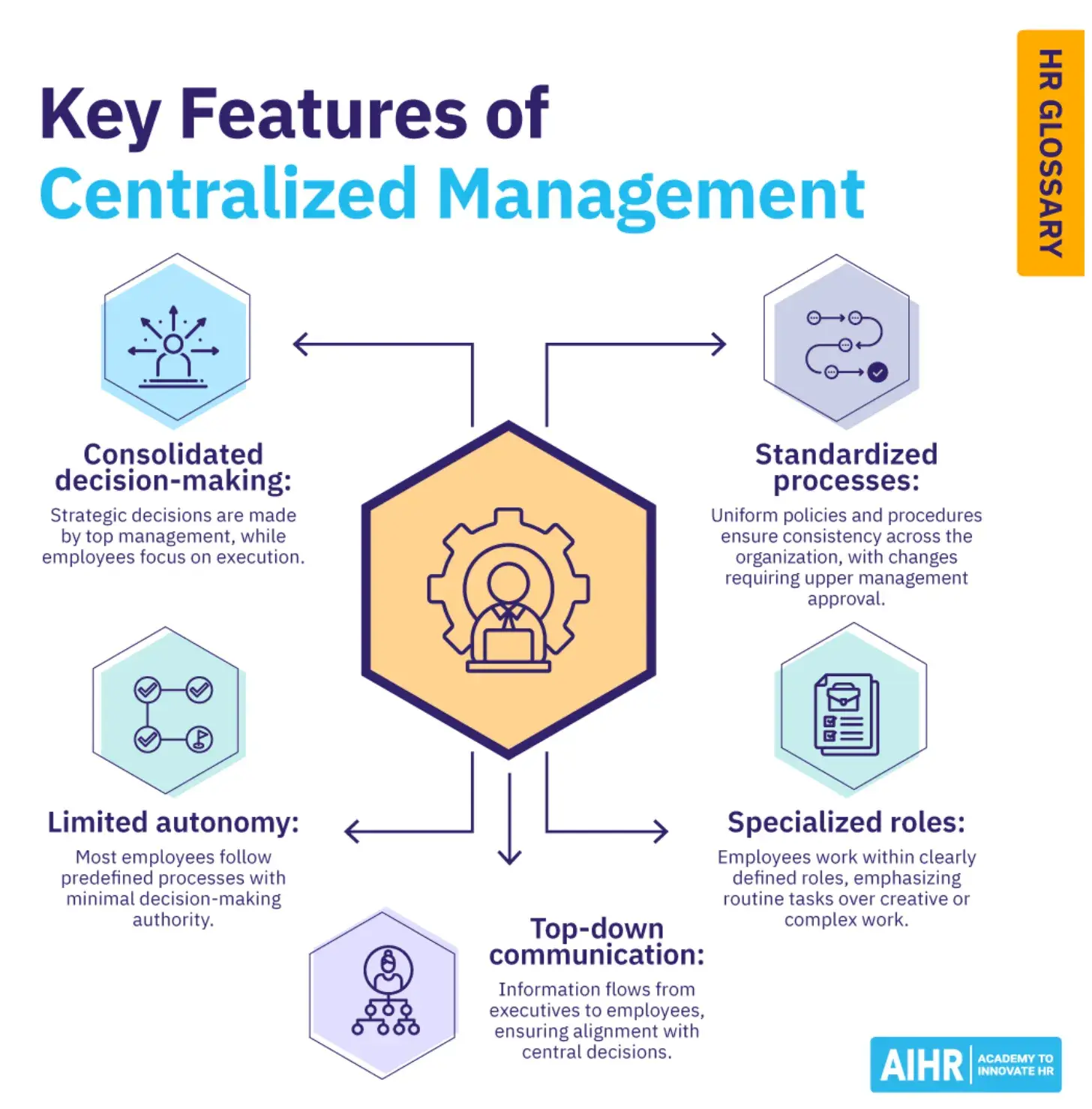
Centralization describes where decisions are ultimately made. Once you‘ve established your chain of command, you’ll need to consider which people and departments have a say in each decision.
A business can lean toward centralized, where final decisions are made by just one or two entities. They can also be decentralized, where final decisions are made within the team or department in charge of carrying out that decision.
Best for: Small to mid-sized businesses or organizations in highly regulated industries needing tight control over decisions.
Below, we‘ll explore how you can combine those components to form different types of organizational structures. We’ll also highlight the benefits and drawbacks of different structure types so you can evaluate which is the best option for your company, division, or team.
Let's dive in.
Mechanistic vs. Organic Organizational Structures
Organizational structures fall on a spectrum, with “mechanistic” at one end and “organic” at the other.
Take a look at the diagram below.
As you'll probably be able to tell, the mechanistic structure represents the traditional, top-down approach to organizational structure, whereas the organic structure represents a more collaborative, flexible approach.

Mechanistic Structure
Mechanistic structures, also called bureaucratic structures, are known for having narrow spans of control, as well as high centralization, specialization, and formalization. They're also quite rigid in what specific departments are designed and permitted to do for the company.
This organizational structure is much more formal than an organic structure, using specific standards and practices to govern every decision the business makes. And while this model does hold staff more accountable for their work, it can become a hindrance to creativity and agility.
As daunting and inflexible as mechanistic structure sounds, the chain of command, whether long or short, is always clear under this model.
As a company grows, it needs to make sure everyone (and every team) knows what's expected of them.
Teams collaborating with other teams as needed might help get a business off the ground in its early stages, but sustaining that growth — with more people and projects to keep track of — will eventually require some policymaking.
Best for: highly-regulated industries and those that handle significant life-or-death situations — hospitals, fire departments, accounting firms, etc.
.png)
Organizational Structure Guide + Templates
Build a visual org structure with these free templates.
- Functional Org Structure
- Geographical Org Structure
- Process-Based Org Structure
- Market-Based Org Structure
Download Free
All fields are required.
.png)
Organic Structure
Organic structures (also known as “flat” structures) are known for their wide spans of control, decentralization, low specialization, and loose departmentalization.
This model might have multiple teams answering to one person and taking on projects based on their importance and what the team is capable of, rather than what the team is designed to do.
This organizational structure is much less formal than mechanistic, and takes a bit of an ad-hoc approach to business needs.
This can sometimes make the chain of command, whether long or short, difficult to decipher. As a result, leaders might give certain projects the green light more quickly, but cause confusion in a project's division of labor.
That said, organic structure empowers employees to try new things and develop as professionals, making the organization’s workforce more powerful in the long run.
Best for: Startups that are navigating a fast-moving industry or simply trying to stabilize themselves after a rough quarter. I have more experience working in and with organic structures, where the organizations are flatter and team members have more leeway. While it’s not a realistic structure for every marketing agency or creative business, I find they often work well for creative teams.
Now, let's uncover more specific types of organizational structures, most of which fall on the more traditional, mechanistic side of the spectrum.
Types of Organizational Structures
- Functional Organizational Structure
- Product-Based Divisional Structure
- Market-Based Divisional Structure
- Geographical Divisional Structure
- Process-Based Structure
- Matrix Structure
- Circular Structure
- Flat Structure
- Network Structure
- Team-Based
There are several types of organizational structures commonly used by companies. I’m diving into 10 of the most popular below, most of which I’ve either worked in or with as clients.
1. Functional Organizational Structure
Best for: Companies with clearly defined job roles that benefit from specialization, especially in stable environments.
One of the most common types of organizational structures, the functional structure, departmentalizes an organization based on common job functions.
An organization with a functional org structure, for instance, would group all of the marketers together in one department, group all of the salespeople together in a separate department, and group all of the customer service people together in a third department.
The functional structure allows for a high degree of specialization for employees and is easily scalable should the organization grow.
Also, this structure is mechanistic in nature, which has the potential to inhibit an employee‘s growth — putting staff in skill-based departments can still allow them to delve deep into their field and find out what they’re good at.
Disadvantages
- Functional structure has the potential to create barriers between different functions, and it can be inefficient if the organization has a variety of different products or target markets.
- The barriers created between departments can also limit peoples' knowledge of and communication with other departments, especially those that depend on other departments to succeed.
Advantages
- Functional organization increases efficiency, provides stability, and boosts accountability.
- It also allows departments — with employees who share similar skills and knowledge — to focus on their specialized tasks within their respective fields.
- Because the roles and responsibilities of this organizational structure example rarely change, department employees can consistently work on similar assignments and hone their skills.
The fixed structure of a functional organization also operates through management. What I like about this type of organizational structure is that employees have a clear chain of command and know exactly who to go to and when.
It guides communication between the team and keeps the team accountable. On the flip side, I’ve found that there’s often a lot of bureaucracy in these organizations, and it can be like pushing a boulder uphill to make even small shifts or decisions.
2. Product-Based Divisional Structure
Best for: organizations with multiple products, and can help shorten product development cycles. This allows small businesses to go to market with new offerings fast.
A divisional organizational structure consists of multiple, smaller functional structures (i.e., each division within a divisional structure can have its own marketing team, sales team, and so on).
In this case, a product-based divisional structure, each division within the organization is dedicated to a particular product line.
Disadvantages
- It can be difficult to scale under a product-based divisional structure.
- The organization could end up with duplicate resources as different divisions strive to develop new offerings.
Advantages
- Companies and their employees can experience the benefits of the product-based divisional structure.
- If one division performs poorly, this does not automatically translate across the organization.
- Because of their separation, divisions may flourish (or fail) concurrently. This system allows companies to mitigate risk.
I’ve found that this type of organizational structure is fantastic because it leads to deep expertise in each division.
However, there can be a lot of redundancy and a lack of brand cohesion with a variety of different marketing departments (likely other types of departments as well, but my experience falls under the marketing category).
3. Market-Based Divisional Structure
Best for: organizations that have products or services that are unique to specific market segments, and is particularly effective if that organization has advanced knowledge of those segments.
Another variety of the divisional organizational structure is the market-based structure, wherein the divisions of an organization are based around markets, industries, or customer types.
This organizational structure also keeps the business constantly aware of demand changes among its different audience segments.
Disadvantages
- Too much autonomy within each market-based team can lead to divisions developing systems that are incompatible with one another.
- Divisions might also end up inadvertently duplicating activities that other divisions are already handling.
Advantages
- Because this organizational structure focuses on specific market segments, it provides each division with autonomy.
- The divisions work separately, which allows employees to work independently and enables them to focus on the needs of their particular industry.
One of the biggest challenges I’ve seen when working with companies using this type of information structure is that the left hand doesn’t always know what the right hand is doing — leading to miscommunication between different departments.
However, the bottlenecks tend to be much smaller than in a functional organizational structure.
4. Geographical Divisional Structure
Best for: organizations that need to be near sources of supply and/or customers (e.g. for deliveries or for on-site support). It also brings together many forms of business expertise, allowing each geographical division to make decisions from more diverse points of view.
The geographical organizational structure establishes its divisions based on — you guessed it — geography. More specifically, the divisions of a geographical structure can include territories, regions, or districts.
Disadvantages
- It can be easy for decision-making to become decentralized, as geographic divisions (which can be hundreds, if not thousands of miles away from corporate headquarters) often have a great deal of autonomy.
- When you have more than one marketing department — one for each region — you run the risk of creating campaigns that compete with (and weaken) other divisions across your digital channels.
Advantages
- Geographical divisions allow companies the advantage of catering to a specific customer. Based on the differences in language, culture, and customs one would find across the world, companies cannot necessarily expect the same operations to work in different locations.
- Not only does it allow organizations to tailor their approach based on geography, but it allows the division to react quickly and efficiently to any geographical market changes.
Candidly, I have a lot of fun working with clients with this type of organizational structure. Each team has a distinct flavor and vibe based on the region, and while it can be challenging to bring them all together, I love the ability to tailor the market so specifically to geographic preferences.
.png)
Organizational Structure Guide + Templates
Build a visual org structure with these free templates.
- Functional Org Structure
- Geographical Org Structure
- Process-Based Org Structure
- Market-Based Org Structure
Download Free
All fields are required.
.png)
5. Process-Based Structure
Best for: improving the speed and efficiency of a business, and is best-suited for those in rapidly changing industries, as it is easily adaptable.
Process-based organizational structures are designed around the end-to-end flow of different processes, such as “Research & Development,” “Customer Acquisition,” and “Order Fulfillment.”
Unlike a strictly functional structure, a process-based structure considers not only the activities employees perform but also how those different activities interact with one another.
To fully understand the diagram below, you need to look at it from left to right: The customer acquisition process can‘t start until you have a fully developed product to sell. By the same token, the order fulfillment process can’t start until customers have been acquired and there are product orders to fill.
Disadvantages
- Similar to a few other structures on this list, process-based structures can erect barriers between the different process groups.
- It may lead to problems communicating and handing off work to other teams and employees.
Advantages
- As mentioned, one of the most significant benefits of the process-based structure is that it increases efficiency and speed. If Department B cannot start its processes until Department A finishes, this compels Department A to work promptly and proficiently.
- This organizational model also promotes intradepartmental (within the department) and interdepartmental (across multiple departments) teamwork.
The biggest problem I’ve seen with this type of organizational structure is that they hit information and sales siloes. So, if this is a structure you use, it’s a good idea to make sure that each department can work well together.
For example, let’s say you have a sales department that focuses on new client acquisition, a department that focuses on installation and onboarding, and another that focuses on maintenance and client support.
I’ve worked with them to find ways to cross-sell and upsell between departments. That ensures that they use similar processes and the same CRM to ensure each is working with the same data for a streamlined and improved client experience. Failure to do so means that you could be leaving a lot on the table.
6. Matrix Structure
Best for: Organizations that want to provide both flexibility and more balanced decision-making (as there are two chains of command instead of just one).
Unlike the other structures we‘ve looked at so far, a matrix organizational structure doesn’t follow the traditional, hierarchical model.
Instead, all employees (represented by the green boxes) have dual reporting relationships. Typically, there is a functional reporting line (shown in blue) as well as a product-based reporting line (shown in yellow).
When looking at a matrix structure org chart, solid lines represent strong, direct-reporting relationships, whereas dotted lines indicate that the relationship is secondary or not as strong. In our example below, it's clear that functional reporting takes precedence over product-based reporting.
Having a single project overseen by more than one business line also creates opportunities for these business lines to share resources and communicate more openly with each other — things they might not otherwise be able to do regularly.
Disadvantages
- The primary pitfall of the matrix organizational structure? Complexity. The more layers of approval employees have to go through, the more confused they can be about who they're supposed to answer to.
- This confusion can ultimately cause frustration over who has authority over which decisions and products — and who's responsible for those decisions when things go wrong.
Advantages
- An advantage of a matrix structure is that it promotes collaboration and communication.
- This open line of communication ultimately allows businesses to share resources and allows employees to develop new skills from working with different departments.
I don’t have as much personal experience with this type of organizational structure, but I can see how it could work well for smaller organizations or companies that offer franchises or work with a variety of independently owned businesses (like dealerships).
7. Circular Structure
Best for: Collaborative, leadership-driven organizations where communication and shared vision flow outward from the center.
While it might appear drastically different from the other organizational structures highlighted in this section, the circular structure still relies on hierarchy, with higher-level employees occupying the inner rings of the circle and lower-level employees occupying the outer rings.
That being said, the leaders or executives in a circular organization aren‘t seen as sitting atop the organization, sending directives down the chain of command. Instead, they’re at the center of the organization, spreading their vision outward.
From an ideological perspective, a circular structure is meant to promote communication and the free flow of information between different parts of the organization.
Whereas a traditional structure shows different departments or divisions as occupying individual, semi-autonomous branches, the circular structure depicts all divisions as being part of the same whole.
Disadvantages
- From a practical perspective, the circular structure can be confusing, especially for new employees.
- Unlike with a more traditional, top-down structure, a circular structure can make it difficult for employees to figure out who they report to and how they're meant to fit into the organization.
Advantages
- Most examples of organizational structure have a top-down hierarchy. Alternatively, this type of structure follows an outward flow and contributes to information flowing freely across the business.
- Its benefits include keeping all employees aligned with the processes and goals of the company and encouraging employees to collaborate between departments.
Like the matrix structure, I have very little experience with a circular structure. While ideologically, I like the idea, it seems quite confusing from a business perspective, especially as the organization grows.
However, if your company is heavily focused on learning, growth, and mentorship, or is mission-driven, this could be an incredible structure that aids growth and communication.
8. Flat Structure
Best for: While I’m not sure how well it would work for a larger company, it’s fantastic for smaller, highly productive, or creative businesses.
A more traditional organizational structure might look more like a pyramid — with multiple tiers of supervisors, managers, and directors between staff and leadership. However, the flat structure limits the levels of management so all staff are only a few steps away from leadership.
It also might not always take the form of a pyramid, or any shape for that matter. As we mentioned earlier, it's also a form of the “Organic Structure” we noted above.
This structure is probably one of the most detailed. Employees can also often be more productive in an environment where there's less hierarchy-related pressures. This structure might make staff feel like the managers they do have are more like equals or team members rather than intimidating superiors.
Disadvantages
- If there's a time when teams in a flat organization disagree on something, such as a project, it can be hard to get aligned and back on track without executive decisions from a leader or manager.
- Because of how complicated the structure's design is, it can be tricky to determine which manager an employee should go to if they need approval or an executive decision for something.
- If you do choose to have a flat organization, you should have a clearly marked tier of management or path that employers can refer to when they run into these scenarios.
Advantages
- The elimination of middle management employees defines the flat structure type. Its advantages are instantaneous. First, it reduces the expenses of the company.
- Second, it allows staff to build direct relationships with upper management.
- Lastly, it shortens the decision-making process.
I love flat structures — one of my first agency experiences was in an organization with a flat structure.
For less experienced team members, it’s easy to get advice and support and to develop mentor-mentee relationships with leadership, whether informal or formal. For more experienced team members, it’s rewarding to help emerging professionals grow.
9. Network Structure
Best for: Companies that don’t do everything under one roof, for example, a company might have an outside, instead of an inside sales team. This is a great way to show employees or stakeholders how outsourcing off-site processes works.
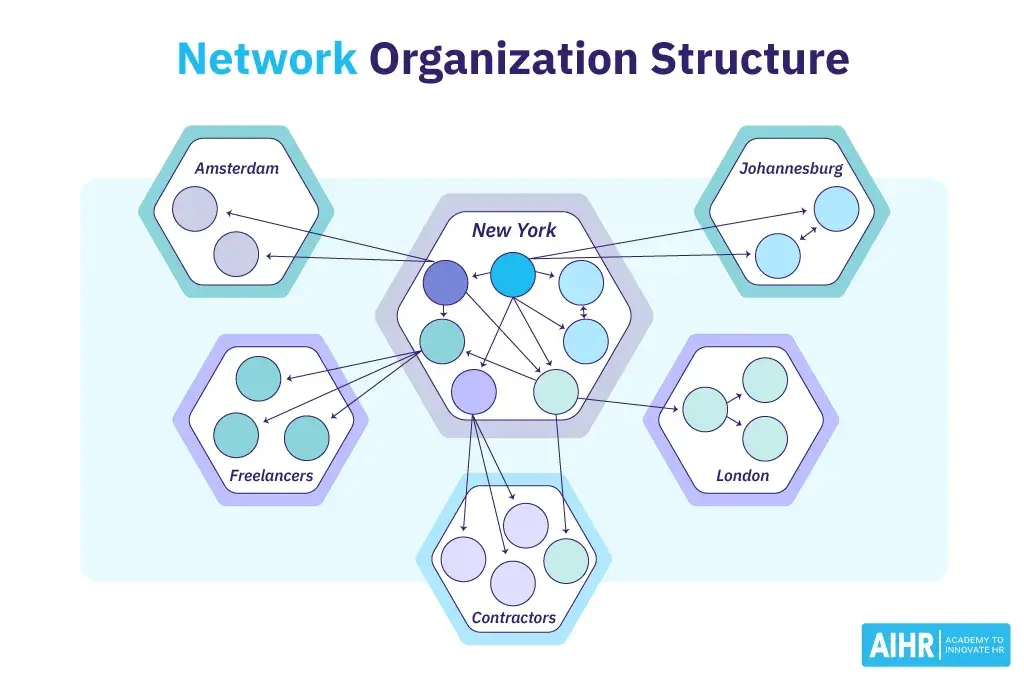
A network structure is often created when one company works with another to share resources, or if your company has multiple locations with different functions and leadership.
You might also use this structure to explain your company workflows if much of your staffing or services is outsourced to freelancers or multiple other businesses.
The structure looks nearly the same as the Divisional Structure, shown above. However, instead of offices, it might list outsourced services or satellite locations outside of the office.
For example, if an employee needs help from a web developer for a blogging project and the company's web developers are outsourced, they could look at this type of chart and know which office or person to contact outside of their own work location.
Disadvantages
- The shape of the chart can vary based on how many companies or locations you‘re working with. If it’s not kept simple and clear, there may be a lot of confusion if multiple offices or freelancers do similar things.
- If you do outsource or have multiple office locations, make sure your org chart clearly states where each specific role and job function lies so that someone can easily understand your basic company processes.
Advantages
- The outsourcing nature of the network structure provides companies with the advantages of lower costs, more focus, and increased flexibility.
- Outsourcing allows organizations to save money, as they don’t have to bear the expense of setting up a department for the same purpose.
- It also gives companies the flexibility to change their processes and the ability to focus on their core functions.
I’m seeing more companies that have a network organizational structure, especially with the push to remote work in the years following the pandemic.
Because these structures are more decentralized, they allow a greater degree of flexibility and autonomy, while still following core ideas. These are also great structures for franchises.
10. Team-Based Organizational Structure
Best for: When I’ve worked with this type of organizational structure for marketing agencies, I found it to be a great way to create deep expertise in specific industries or verticals.
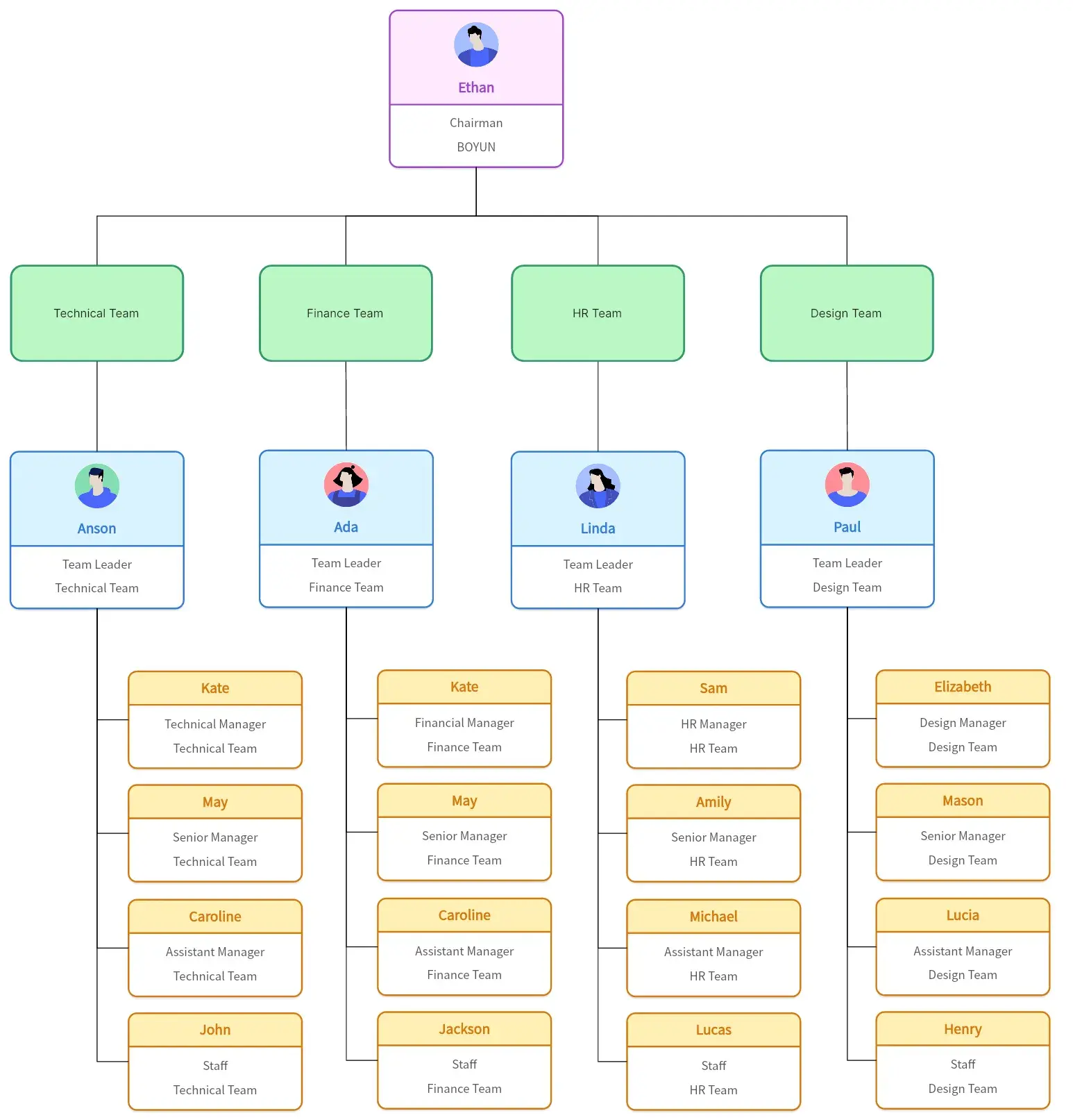
A team-based organizational structure is designed to give team members enough freedom and leeway to work towards the organization’s goals without significant bottlenecks.
And while team-based structures can look a lot like divisional or functional structures, the focus is on a self-managing group of largely autonomous employees.
Team-based organizations might use words like “Scrum teams” and focus on problem-solving, rapid iteration, and performance instead of a traditional hierarchy.
If your company is agile, has multiple priorities, or develops a variety of product types, a team-based structure could be a great fit because it gives your employees more ownership of the task(s) at hand.
Disadvantages
- If your company has used a traditional hierarchical structure, it may take some significant work to get leadership on board, since it’s a drastically different way of thinking about how work gets done.
- Because it changes the traditional career models and values cooperation, the path for promotions may not be as clear for your team.
Advantages
- Because the whole team is involved in the entire task or goal, there are very few information silos, and when one person gets overloaded, someone else can often step in to help.
- It focuses on a growth mindset , which helps people and companies progress.
- These teams are so self-reliant that they don’t need a lot of oversight.
- Team-based organizations are often highly productive and perform strongly.
As someone who likes to take action, test things, and then perfect them (or find a better solution), I love working with agile team-based organizational structures.
They make decisions quickly and focus on getting things done one step at a time.
They’re fantastic for tech companies, startups, and digital transformation experts. I’ve also found they can be great for marketing agencies, because the structure allows them to pivot rapidly with shifts in the market.
.png)
Organizational Structure Guide + Templates
Build a visual org structure with these free templates.
- Functional Org Structure
- Geographical Org Structure
- Process-Based Org Structure
- Market-Based Org Structure
Download Free
All fields are required.
.png)
Organizational Structure Examples
Organizational structure can both refer to your company’s structure at large, or your individual teams. No matter what, you usually want to have a different structure for each department due to the distinct needs and functions of each one.
We’ll start with organizational structure examples for both companies, then delve into team-specific charts.
1. Company Organizational Structure Example: Matrix Type
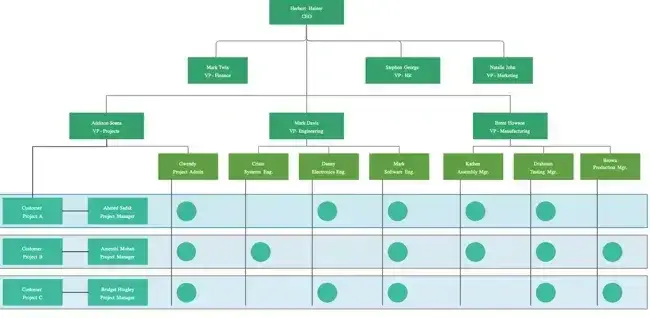
This matrix organizational structure example for an imaginary engineering company starts with the CEO at the helm.
However, instead of including a C-suite (such as a chief marketing officer, a chief finance officer, a chief technology officer, and so on), it includes vice presidents who then oversee individual contributors.
Each contributor works cross-collaboratively with members of other teams on a specific customer project. In my opinion, this type of organizational structure is a good example to follow if you run a small-to-medium company in a project-based or region-based firm.
Top tip: Where you have teams working cross-collaboratively, it’s essential to have a detailed report of what’s happened on customer accounts. In HubSpot’s Service Hub you can track customer accounts and interactions so all team members have account history in one easy-to-update place.
2. Marketing Organizational Structure Example: Functional Type

A marketing team’s organizational structure will vary depending on the size of the company. In this example, we see a functional structure type, where the teams are split based on job function.
Here, the marketing team is headed by a chief marketing officer (CMO), who oversees smaller departments divided into six functions: Social media, content, product, SEO, website, and acquisition.
Your marketing team, however, can also adopt a matrix organizational structure if you laterally divide your individual contributors and managers based on region, country, project, or another factor. While this isn’t my favorite option for marketing organizations, it can be highly effective as the company grows.
Top tip: Midsize marketing teams are likely creeping into multi-marketing channels, tools, strategies, and more, With HubSpot’s Marketing Hub you can measure and optimize your marketing in one place. Plus, the AI features make light work of marketing, so your team can scale leads and revenue faster.
3. Sales Organizational Structure Example: Functional Type
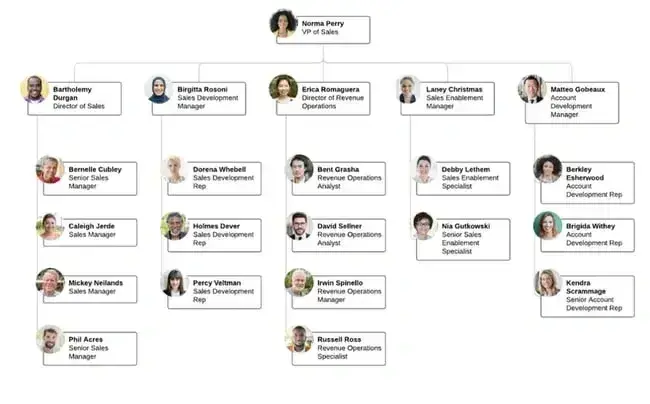
In many sales organizations, organizational structures are deeply hierarchical, where a vice president of sales oversees a director of sales, and then the director of sales oversees a team of sales managers, and the sales managers oversee a team of sales representatives, and so on.
In this example of a sales organizational structure, roles are not as hierarchically structured and instead are divided based on function.
The VP of sales oversees a varied team, which includes a director of sales, a sales development manager, a director of revenue operations, a sales enablement manager, and an account enablement manager.
While these are each at different stages of their careers, they are all at the same level and are responsible for a specific function within the team.
Top tip: If you’ve got sales teams at different levels working together, then you can integrate AI tools to help with the decision-making process so senior members can be assured that junior team members are supported. HubSpot’s Sales Hub has AI-powered sales tools that help with lead scoring. Your sales teams will be made aware of triggers with suggested actions based on data.
4. Service Organizational Structure: Process-Oriented Structures
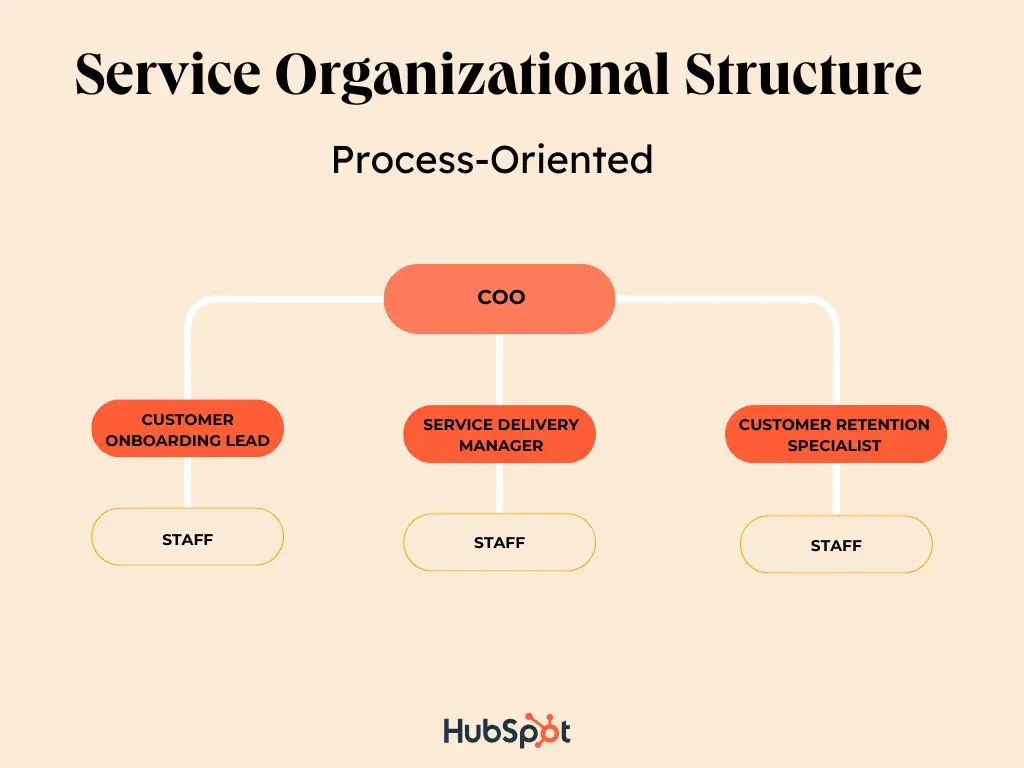
A service-oriented business may structure the company around the processes that deliver value to the customer.
This type of structure might suit an IT support company. At the top is the Chief Operations Officer (COO), who oversees the entire service delivery function. Beneath them, the organization is structured around key service processes rather than departments or job roles.
For example, there may be a Customer Onboarding lead who manages the process of welcoming and setting up new clients, a Service Delivery manager who oversees ongoing client support, and a Customer Retention specialist who works proactively to ensure client satisfaction and long-term engagement.
Top tip: You don’t need to remember every single process. Instead, you can use tools like HubSpot’s Operations Hub, where you can automate actions.
Organizational Structure: Things to Know
What is an organizational structure chart?
An organizational structure chart is a diagram that shows your departments, starting from C-Suite leaders to individual contributors, as well as your company’s order of command and decision-making flow.
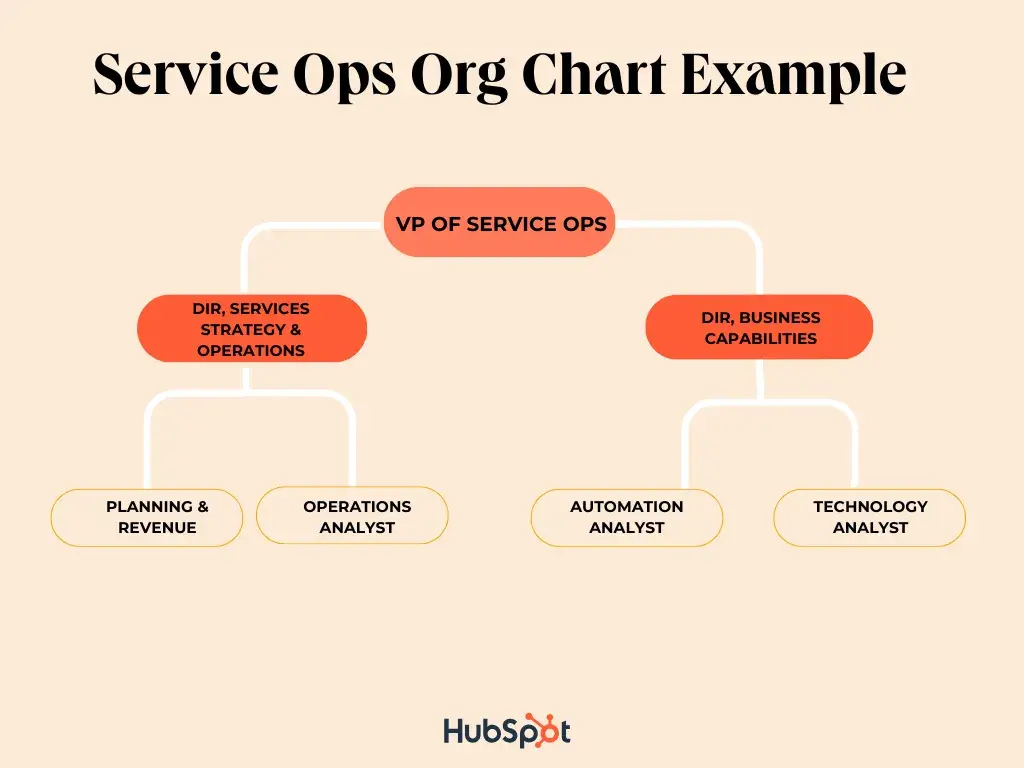
Why is having an organizational structure important?
If your business had no organizational structure, it would be virtually impossible to onboard new team members, and likely lead to high staff turnover.
If I were coming into an organization without a functional organizational structure, I’d have questions arise about the systems and processes as well as things like:
- Who makes the decisions?
- How are employees held accountable?
- What are the company’s goals?
Organizational structure is necessary for running a successful business because it improves workflow and efficiency, promotes communication, identifies company needs, and aligns employees with company goals. It directly affects how your business operates daily.
When you establish a structure that works, the combined efforts of your employees, in conjunction with your systems and processes, allow your company to make better decisions for its future.
What is the best organizational structure?
First and foremost, there’s no such thing. I’ve shared some of the pros and cons of each, as well as my professional experiences. Suffice it to say, the best organizational structure varies from business to business and largely depends on your team size, company type, and product offerings.
Not sure what you need? A functional organizational structure (also named “traditional line organizational structure” or “hierarchical structure”) is an excellent place to start if you’re not sure which org structure is right for you.
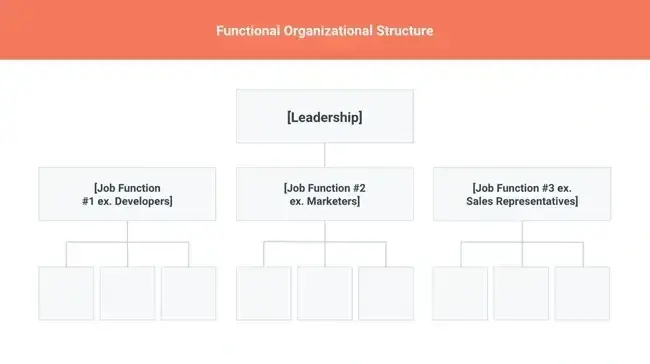
What are the four basic forms of organizational structure?
The four basic forms of organizational structure are:
- Functional.
- Divisional.
- Matrix.
- Flat.
Functional organizational structures divide your company teams based on job functions and responsibilities.
Divisional organizational structures group your teams based on products, markets, or regions, with smaller organizational structures for each division of your business.
Matrix organizational structures divide your company teams in a grid-based fashion, where every team has dual reporting relationships with the C-Suite and another team.
A flat organizational structure keeps hierarchy to a minimum by eliminating middle management and keeping individual contributors as close as possible to leadership.
How do businesses determine organizational structure?
Businesses determine organizational structure by taking stock of their current workforce and teams, then carefully aligning their company strategy, employee feedback, and leadership goals with a specific structure.
Some companies may have naturally fallen into a functional org structure, in which case it’s only a matter of creating an org diagram. Others may be in the process of creating one. Here are the steps to determine an org structure from scratch:
- Audit your organization’s teams and roles. First, it’s essential to understand which teams and roles already exist within your business. If your business is new, create a list of planned teams and hires.
- Draft a company strategy. Your org structure should support your strategy, not detract from it. If your strategy is to launch X new products in the market, then a product-based divisional structure might work well for you.
- Gather feedback from existing employees. Your existing employees are a gold mine of information when creating an organizational structure. Some employees might want to be closer to leadership; others might want advancement opportunities. For the first, a flat structure would fit, and for the second, a functional structure would be best.
- Gather feedback from other leaders. Just as employees’ voices matter, so, too, do leaders’ voices matter. Understand their key goals and the support they need to do their best work at your firm.
- Align your company strategy, employee feedback, and leadership feedback with an org structure. Take a look at organizational structure types and try to align them with the data and observations you’ve collected. Sometimes, the decision will be clear; other times, you’ll need to continue interviewing and gathering data to find the best structure for you.
- Create an org chart. Now that you’ve chosen the right org structure, it’s time to create a visual chart that shows your company’s chain of command, departmentation, span of control, and centralization at a minimum. Share this chart via email, and be sure to keep it in an easy place for all employees to access.
Navigating Organizational Structures
Organizational structures are central to a successful team. Employees can move comfortably, confidently, and efficiently when given a clear definition of their role within an organization.
Structure types will vary from business to business, so it’s important to remember that these structures are not one-size-fits-all all. Every type may not suit your organization, but chances are, one of them will.
Use this post to determine which organizational structure works for you, and then it’s time for the real work to begin … but it’s also where I’ve seen the most growth happen. Have fun!
Editor's note: This post was originally published in December 2014 and has been updated for comprehensiveness.
.png)
Organizational Structure Guide + Templates
Build a visual org structure with these free templates.
- Functional Org Structure
- Geographical Org Structure
- Process-Based Org Structure
- Market-Based Org Structure
Download Free
All fields are required.
.png)
Management
.png?width=112&height=112&name=Image%20Hackathon%20%E2%80%93%20Vertical%20(19).png)

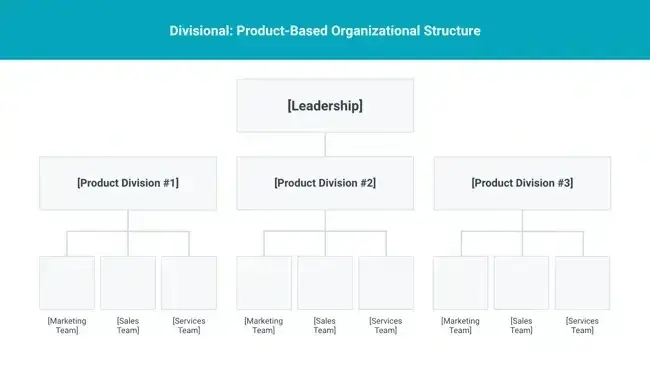
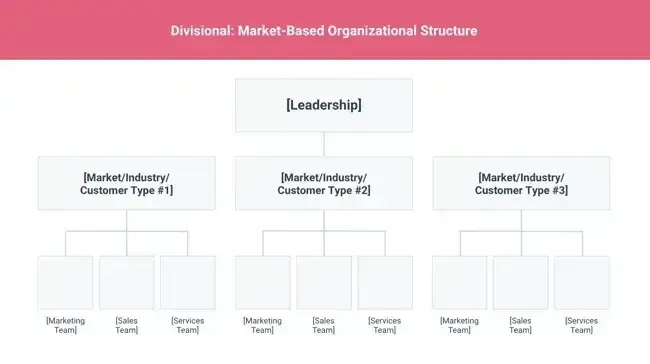




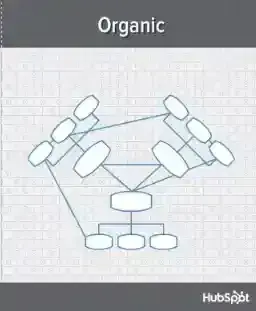




![Why Every Company Needs an Operating Model [+ Steps to Build One]](https://53.fs1.hubspotusercontent-na1.net/hubfs/53/Operating%20Model.webp)

![5 Clues You Micromanage and How to Stop [Quiz]](https://53.fs1.hubspotusercontent-na1.net/hubfs/53/micromanage-definition.jpg)


